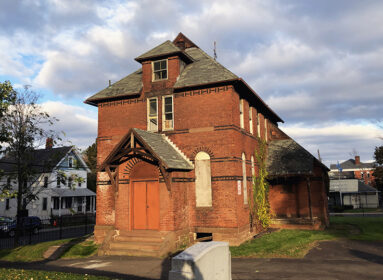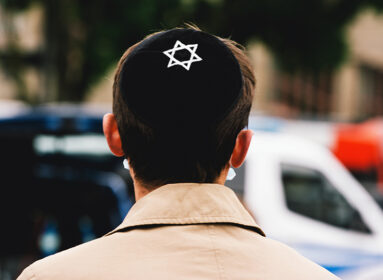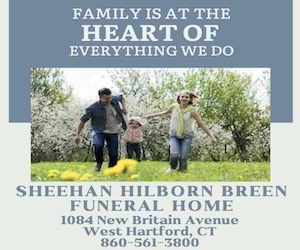
This Henry Street Settlement "visiting nurse" is using rooftops to go from house to house to save climbing up and down stairs. Institution: American Jewish Historical Society
During the first half of the twentieth century, Jewish women who wished to train as nurses had to deal with a range of challenges, both as Jews and as women: As Jews, they faced quotas in nursing school admissions, hiring discrimination at hospitals, and the Christian environment of nursing schools; as women, they were forced to confront parental bias against women’s higher education and nursing schedules which precluded marriage and raising a family. Despite the odds, numerous Jewish women entered a career in nursing.
During the Civil War years, Phoebe Yates Levy Pember, not a trained nurse, distinguished herself as matron and administrator of the large Chimborazo Hospital in Richmond, Virginia, capital of the Confederacy. During this same time, another Jewish woman, Hanna Sandusky, distinguished herself as a midwife in Pittsburgh, Pennsylvania. A truly righteous woman, she served as a matchmaker, collected money and linens to marry off poor girls, and sewed shrouds for the dead. She never charged a fee and presided at 3,571 registered births, her last, at age eighty-two, in 1909.
In “A Generation of Women: Education in the Lives of Progressive Reformers” (1979), Ellen Lagemann termed her research subjects the “progressive generation” because they were a “pioneer” generation in the history of American women. Early leaders during this period included Lillian Wald, Amelia Greenwald, Naomi Deutsch, Blanche Pfefferkorn, and Regina Kaplan (several of these women are highlighted below). Rae Landy and Rose Kaplan were the first American nurses in Palestine as Hadassah was being established. Another interesting personality, Emma Goldman attended midwifery school in Vienna, Austria, and returned to the Lower East Side to work as a midwife among the indigent Jewish immigrants.
In 1873, Bellevue Hospital in New York City established its school of nursing. That same year, New Haven Hospital and Massachusetts General Hospital also established schools. Mount Sinai Hospital, in New York City, opened the Mount Sinai Training School for Nurses in March 1881. The newly formed school had no difficulty in attracting students. While the Mount Sinai Training School for Nurses was nonsectarian, constant efforts were made to attract eligible Jewish girls. Thirty such applications were received during the first year; seventeen applicants were accepted into the first class of forty-three.
Jewish nurses served with distinction in the Spanish Civil War, World War I and II, as well as in every instance where American soldiers have been mobilized. Jewish nurses who have provided leadership to the profession since the middle of the twentieth century, include Rachel Bliss, Felissa Cohen, Adele Herwitz, and Ingeborg Mauksch. Thelma Schorr retired as editor of the American Journal of Nursing. June Rothberg, Jacqueline Rose Hott, Claire Fagin, Harriet Feldman, and Janice Selekman have been, or are, deans at schools of nursing. Nettie Birnbach only recently stepped down as president of the New York State Nurses Association. The list is extensive.
Careful Jewish quotas on admittance to nursing school were maintained, probably until the establishment of the U.S. Cadet Nurse Corps in 1943. Moving nursing education into the collegiate setting resulted in an increase in Jewish nurses. The elimination of quotas on school admissions also helped. A college education and being able to live at home made a career in nursing acceptable to Jewish parents.
Hadassah Nurses Councils were formed in 1989 to encourage Jewish nurses to join and network together. The Raphael Society of the Association of Orthodox Jewish Scientists also encourages Jewish nurses to join. The many and varied accomplishments of Jewish women in nursing are finally being chronicled.
This is an excerpt of an article by Susan L. Mayer that appears on Jewish Women’s Archive (www.jwa.org).








 Southern New England Jewish Ledger
Southern New England Jewish Ledger










